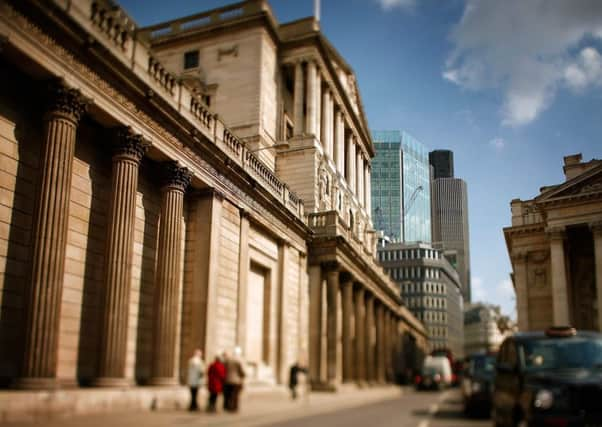Bill Jamieson: Where will interest rates go from here?
This article contains affiliate links. We may earn a small commission on items purchased through this article, but that does not affect our editorial judgement.


It would be the first rate rise in nine years and bring an end to the derisory rates of interest being paid on bank and building society accounts.
With 90-day notice savings accounts down at 1.4 per cent and instant access rates hovering around 1.1 per cent, it has hardly seemed worth saving at all.
Advertisement
Hide AdAdvertisement
Hide Ad• READ MORE: Sterling surges as BoE moves closer to rates hike
In a surprisingly close decision last week, three members of the Bank’s monetary policy committee voted for a rise in rates from their current 0.25 per cent, cutting the majority for “no change” to just two. Minutes of the meeting showed external members Ian McCafferty and Michael Saunders joined Kirstin Forbes, the previous lone “hawk”, in calling for a reversal of last August’s cut in the base rate to curb the growing threat of inflation.
Coinciding with another rise in official US interest rates last week, might the long era of emergency low money costs be coming to a close at last? Up till last week, money markets had not been expecting any change in rates until next year. But the weakness of sterling pushed the consumer prices index up to 2.9 per cent last month – well above the bank’s 2 per cent target.
• READ MORE: Holiday costs push inflation towards four-year high
The case for action is even more compelling when the traditional inflation measure – the retail prices index – is taken into account. This index, which includes housing costs such as council tax and is arguably a more accurate measure of the real-world inflation pressure on households, is now running at 3.7 per cent. And it is this that is cutting deeply into household spending power, with average earnings outside of bonuses, rising by just 1.3 per cent in the three months to April.
Some now expect a rate hike could come as early as this autumn. The immediate reaction was a rally in the pound, which closed the week at $1.2790 – still well below the $1.295 at which it stood prior to the shock news of the election result and a hung parliament.
But an early rate rise is by no means assured. Business and household confidence has been hit by uncertainties over Brexit and how long the stricken premiership of Theresa May can survive. The economy is already slowing, and unlikely, even on the Bank of England’s latest 1.9 per cent growth forecast, to do much more than sputter along.
Advertisement
Hide AdAdvertisement
Hide AdAnd the consumer sector, for so long a critical prop for the UK economy, is weakening. Last month saw a bigger-than-expected fall of 1.2 per cent in retail sales, heightening fears over the outlook for companies exposed to the domestic economy. Consumer-facing “mid cap” shares such as Restaurant Group, Howden Joinery and Dunelm Group dived by more than 6 per cent, pulling the FTSE 250 Index sharply lower on Thursday before a modest rally by the weekend. DFS Furniture was a notable weak spot, its shares plunging 21 per cent after warning that profits would be lower this year.
ONS figures show spending on household goods stores plunged 5.7 per cent month on month – and were down 6.4 per cent over the year. Sales of furniture and lighting have fallen 7 per cent over the year and electrical appliances are 4.8 per cent down.
It seems astonishing that, after nine years of crisis-level interest rates and bucket-loads of quantitative easing, the UK economy is in still such an enfeebled state and savers have had to endure such derisory returns on savings. Many – especially those in or near retirement – are reluctant to commit their nest-eggs to an unpredictable stock market.
And among economists there is a growing worry that the distorting effects of artificially cheap money are piling up problems in bank lending books. Yet today, with falling real disposable incomes and fragile business confidence, it hardly seems appropriate to begin a “return to normal” on interest rates.
As it is there are several pending changes to the composition of the bank’s rate-setting committee, including the departure of “hawk” Kirstin Forbes, so it is by no means certain that support for a rise in rates will glide automatically towards a majority.
The doves on the MPC hope that the “warning shot” on rates may be enough to steady the pound for now and stop currency-linked inflation pressures getting worse. But that depends on no further political mishaps befalling Theresa May’s minority administration. With restiveness on the back benches over the Prime Minister’s performance and fraught Brexit negotiations starting this week, that cannot be counted on.
A rate rise may have moved closer – but not yet close enough to be undertaken with comfort.